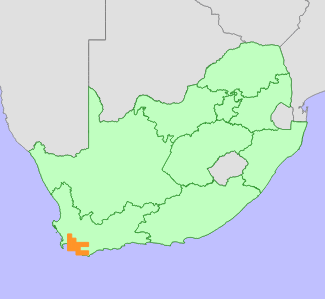|
Scientific Name | Phylica gracilis (Eckl. & Zeyh.) D.Dietr. |
Higher Classification | Dicotyledons |
Family | RHAMNACEAE |
National Status |
Status and Criteria | Near Threatened B1ab(ii,iii,iv,v) |
Assessment Date | 2012/07/09 |
Assessor(s) | N.A. Helme & L. von Staden |
Justification | EOO 6395 km², although formerly widespread and common, this habitat specialist is becoming increasingly rare. Around 20 remaining locations continue to decline due to ongoing habitat loss to crop cultivation, urban expansion and competition from alien invasive plants. |
Distribution |
Endemism | South African endemic |
Provincial distribution | Western Cape |
Range | Malmesbury to Elim. |
Habitat and Ecology |
Major system | Terrestrial |
Major habitats | South Sonderend Sandstone Fynbos, Overberg Sandstone Fynbos, Kogelberg Sandstone Fynbos, Hawequas Sandstone Fynbos, Agulhas Limestone Fynbos, Greyton Shale Fynbos, Elgin Shale Fynbos, Cape Winelands Shale Fynbos, Boland Granite Fynbos, Elim Ferricrete Fynbos, Hangklip Sand Fynbos, Western Coastal Shale Band Vegetation |
Description | Lower sandy slopes and flats, often on ecotone between sandstone and shale. |
Threats |
| Phylica gracilis has lost habitat to forestry plantations in the past in Jonkershoek, around Franschhoek, Grabouw and Bot River, but forestry plantations are no longer expanding and this threat has largely ceased. Around Grabouw, Elgin, Theewaterskloof, the lower southern slopes of the Riviersonderend Mountains around Greyton, and the Palmiet River Valley south of Grabouw, habitat loss to crop cultivation is ongoing. On the Bredasdorp Mountains near Napier, subpopulations are threatened by ongoing habitat loss to expanding vineyards. Most remaining subpopulations on lower slopes around Franschhoek, Houw Hoek, the Kleinrivier Mountains, and the Agulhas Plain inland of Gansbaai are threatened by competition from unmanaged alien invasive plants. Habitat loss to urban expansion is also threatening subpopulations around Kleinmond and Bot River. |
Population |
A large number of historical records indicate that Phylica gracilis was fairly common in the past, however, it is becoming increasingly rare due to ongoing habitat loss (N.A. Helme pers. comm. 2012). It appears to be a habitat specialist preferring transitional areas between sandstone and shale soils, and as a result, subpopulations tend to be localized. Most recently recorded subpopulations are small and are declining due to competition from alien invasive plants or threatened by habitat loss.
|
Population trend | Decreasing |
Assessment History |
Taxon assessed |
Status and Criteria |
Citation/Red List version | | Phylica gracilis (Eckl. & Zeyh.) D.Dietr. | Least Concern | 2012.1 | | Phylica gracilis (Eckl. & Zeyh.) D.Dietr. | Least Concern | Raimondo et al. (2009) | |
Bibliography |
Goldblatt, P. and Manning, J.C. 2000. Cape Plants: A conspectus of the Cape Flora of South Africa. Strelitzia 9. National Botanical Institute, Cape Town.
Pillans, N.S. 1942. The genus Phylica, Linn. Journal of South African Botany 8(1):1-164.
Raimondo, D., von Staden, L., Foden, W., Victor, J.E., Helme, N.A., Turner, R.C., Kamundi, D.A. and Manyama, P.A. 2009. Red List of South African Plants. Strelitzia 25. South African National Biodiversity Institute, Pretoria.
|
Citation |
| Helme, N.A. & von Staden, L. 2012. Phylica gracilis (Eckl. & Zeyh.) D.Dietr. National Assessment: Red List of South African Plants version 2024.1. Accessed on 2025/12/23 |
 Comment on this assessment
Comment on this assessment


